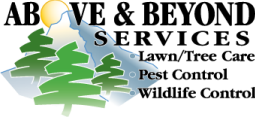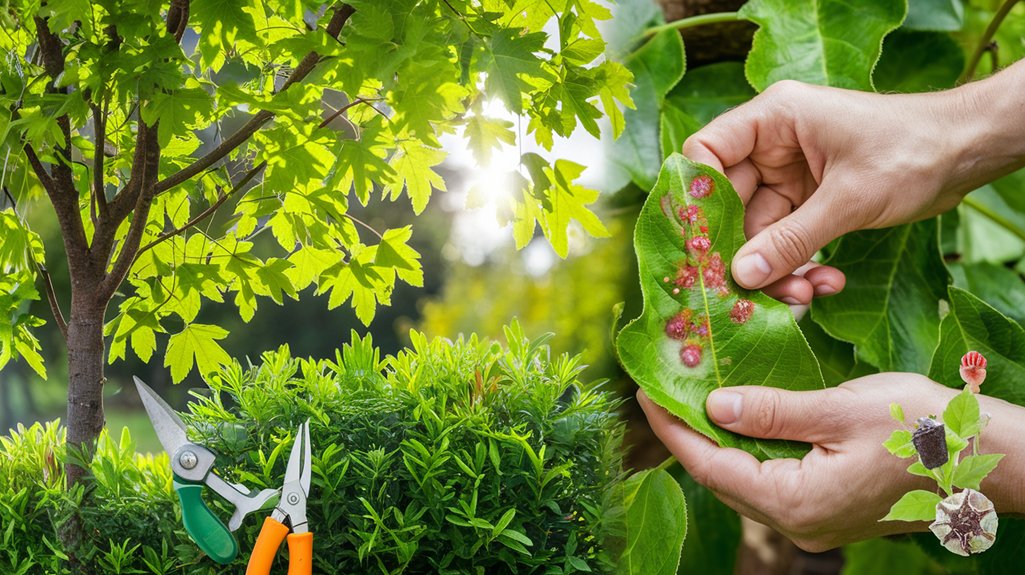You might not realize how much your trees and shrubs depend on your care to thrive. Identifying diseases and pests early can make all the difference in your garden’s health. By incorporating simple, proactive measures, you can protect your plants and promote their vitality. Curious about the best practices for maintaining robust growth and minimizing threats? Let’s explore some expert strategies that can transform your approach to plant health care.
Understanding Common Tree and Shrub Diseases
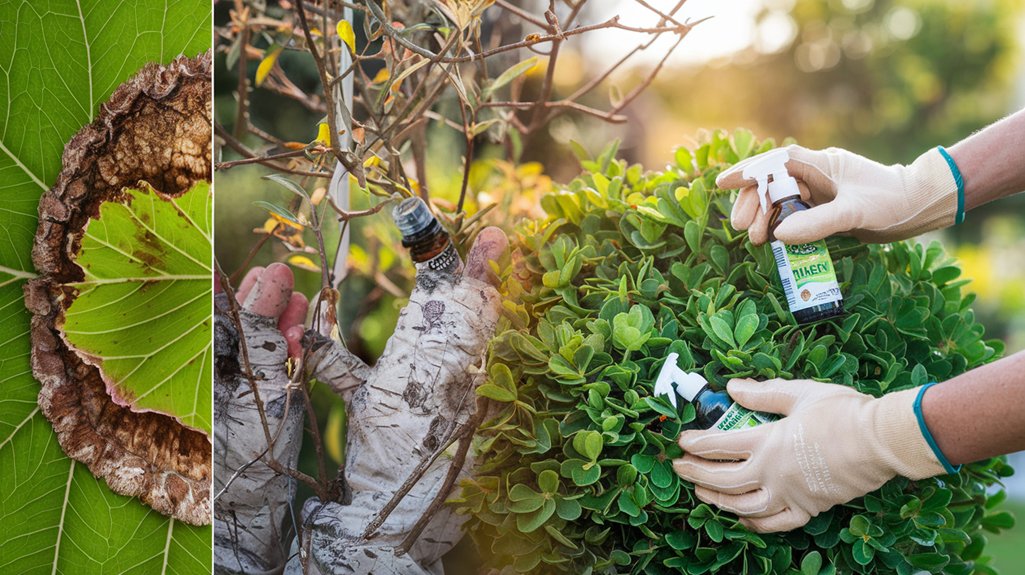
When you’re caring for your trees and shrubs, it’s essential to recognize the common diseases that can threaten their health.
Fungal infections often manifest as discolored leaves, wilting, or unusual growths. You might notice powdery mildew or root rot, both of which can severely weaken your plants.
On the other hand, viral diseases can lead to stunted growth and mottled leaves, making it crucial to identify these issues early on.
Regularly inspecting your plants for signs of distress will help you take action before the problem escalates.
Remember to maintain proper care routines, like watering and pruning, to prevent these diseases.
Identifying Pests That Affect Plants
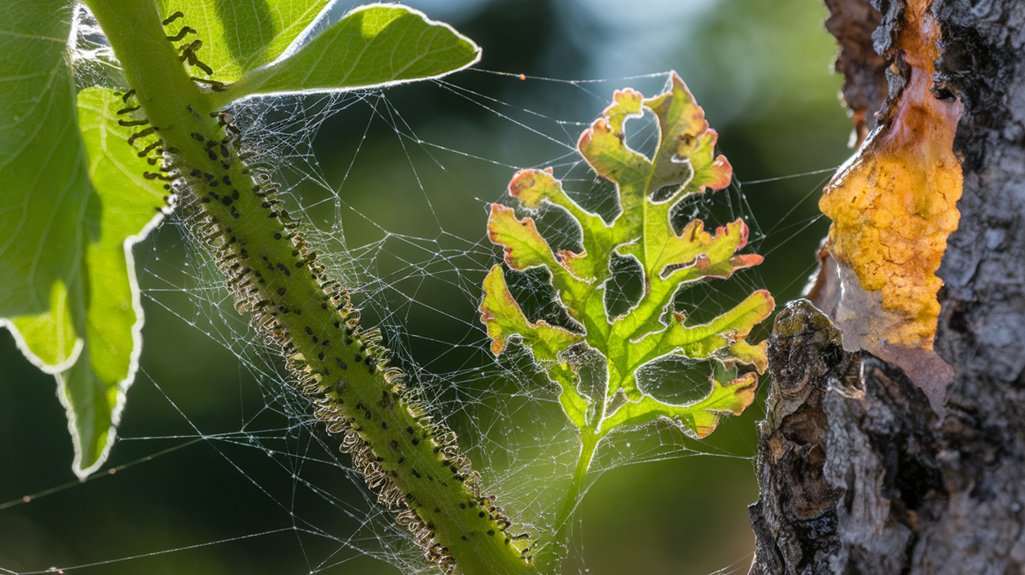
How can you tell if pests are wreaking havoc on your plants? Start by observing the leaves and stems for signs like discoloration, holes, or sticky residue. These symptoms often point to pest activity.
For effective pest identification, familiarize yourself with common insects in your area, such as aphids, spider mites, and caterpillars. Pay attention to insect behavior; for instance, aphids cluster on new growth while spider mites leave fine webbing.
Don’t forget to check the undersides of leaves, where many pests like to hide. Regular monitoring helps you spot issues early, ensuring your trees and shrubs stay healthy.
With practice, you’ll become adept at recognizing the signs of pest problems before they escalate.
Essential Practices for Preventative Care
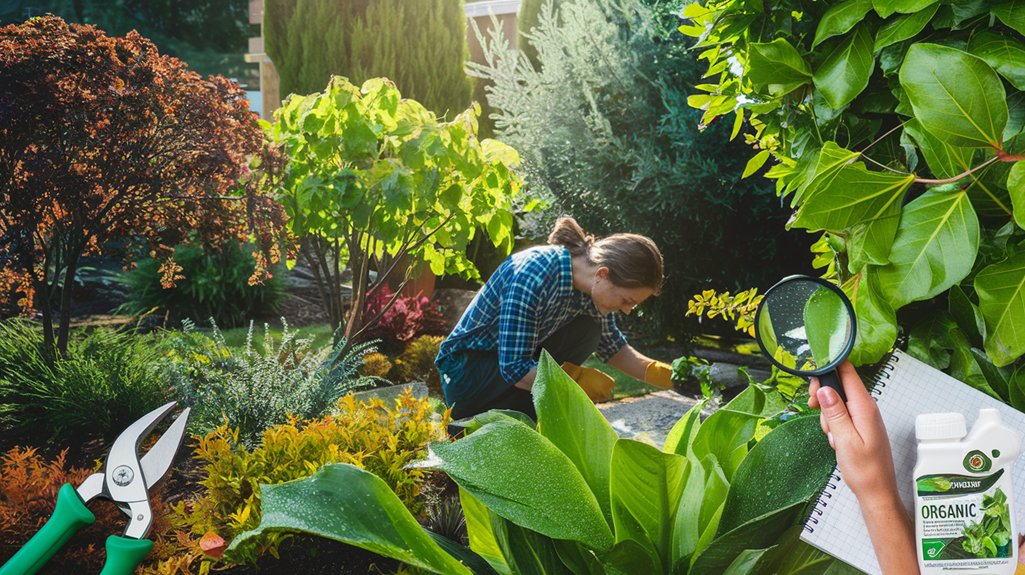
Preventative care is crucial for maintaining the health of your plants and can save you time and effort in the long run. Start by focusing on soil health; healthy soil provides essential nutrients and supports strong root systems. Test your soil regularly to ensure it’s balanced and amend it as needed.
Seasonal maintenance is also key. In spring, prune your trees and shrubs to encourage growth and remove any dead or diseased branches. Mulching helps retain moisture and suppress weeds.
During the fall, clean up debris to prevent pests and diseases from overwintering. Regular watering, especially during dry spells, strengthens plants and keeps them resilient.
Plant Health Care ensures thriving gardens. Learn more from Colorado State University Extension.
Natural Remedies and Sustainable Solutions
Maintaining healthy plants often means turning to natural remedies and sustainable solutions that work in harmony with the environment.
You can start by using organic fertilizers, which enrich the soil without harmful chemicals. Compost and well-rotted manure are excellent choices that promote strong root systems and vibrant growth.
When it comes to pest control, consider natural pesticides like neem oil or insecticidal soap. These options effectively target pests while being safe for beneficial insects and the ecosystem.
Additionally, introducing beneficial insects, such as ladybugs, can help manage pest populations naturally.
Monitoring and Early Detection Techniques
While you nurture your garden, keeping an eye out for signs of distress can make all the difference in plant health.
Here are some effective monitoring and early detection techniques to implement:
- Visual Inspection: Regularly check your plants for unusual discoloration, wilting, or spots. This can help you spot issues before they escalate.
- Soil Testing: Test your soil for nutrient levels and pH. Imbalances can lead to stress and vulnerability to pests and diseases.
- Pest Traps: Use sticky traps to catch flying insects. This gives you a heads-up on potential infestations.
- Regular Watering Checks: Ensure your plants are neither overwatered nor underwatered, as this can lead to weakened health.
When to Seek Professional Help
When should you consider calling in a professional for your plants? If you notice signs of urgency—like rapid leaf drop, visible pests, or unusual discoloration—it’s time to act.
These symptoms often indicate serious issues requiring expert evaluation. Don’t wait until the damage spreads; early intervention is key to saving your trees and shrubs.
If you’re unsure about the severity of the problem, a professional can provide the guidance you need. They can diagnose the issue accurately and recommend effective treatments tailored to your plants.
Frequently Asked Questions
How Can I Improve the Soil Health for My Trees and Shrubs?
To improve soil health for your trees and shrubs, you can add soil amendments like compost and use organic fertilizers. These practices enhance nutrient availability, promote microbial activity, and ultimately support robust plant growth and resilience.
What Are the Signs of Stress in Trees and Shrubs?
You’ll notice signs of stress in your trees and shrubs through leaf discoloration, wilting leaves, stunted growth, bark damage, root rot, and pest infestations. Address these issues quickly to restore their health and vitality.
Can Companion Planting Help Prevent Plant Diseases?
Companion planting can significantly aid in disease prevention. When you strategically plant compatible species together, they can enhance each other’s growth, deter pests, and create a healthier environment, ultimately reducing the risk of plant diseases.
How Does Weather Affect Pest Populations in Plants?
Weather significantly impacts pest populations. You’ll notice pest migration often aligns with changing weather patterns and seasonal fluctuations. Temperature extremes can either exacerbate infestations or reduce pest numbers, affecting your plants’ overall health.
What Are the Best Times for Pruning to Prevent Disease?
To prevent disease, you’ll want to focus on seasonal timing for pruning. Early spring and late fall are ideal times, as proper pruning techniques during these seasons minimize stress and reduce the risk of infection.
By implementing these expert tips, you can keep your trees and shrubs healthy and thriving. Regular inspections and proactive measures help you catch potential issues early, while maintaining soil health and using natural remedies can minimize the need for harsh chemicals. Remember, a vibrant garden starts with you! Stay vigilant and attentive to your plants’ needs, and don’t hesitate to seek professional help if you spot something concerning. Your green space will thank you for it!
Contact Us
Plant Health Care with Above & Beyond Services keeps your Denver trees and shrubs thriving. Call (720) 806-6378 or visit Above & Beyond Services for free quotes on plant care, pest control, and more.
Key Takeaways
- Regularly inspect trees and shrubs for signs of diseases and pests, such as discoloration, wilting, or holes in leaves.
- Maintain soil health with organic fertilizers and compost to support strong root systems and overall plant vitality.
- Implement seasonal maintenance practices, like pruning and debris removal, to promote healthy growth and reduce disease risk.
- Use natural remedies, such as neem oil and beneficial insects, to manage pests without harming the environment.
- Monitor plants closely for early detection of issues, including visual inspections and soil testing for nutrient imbalances.
